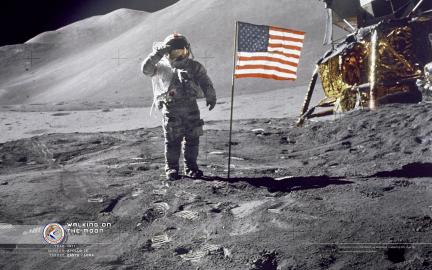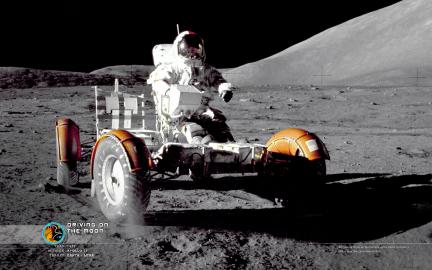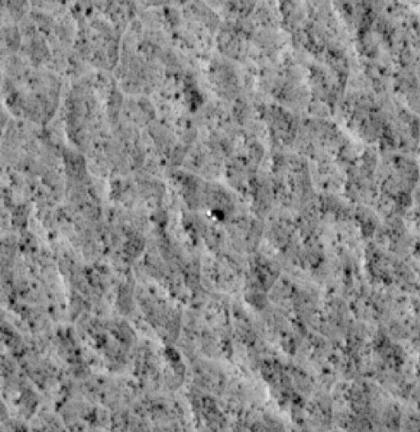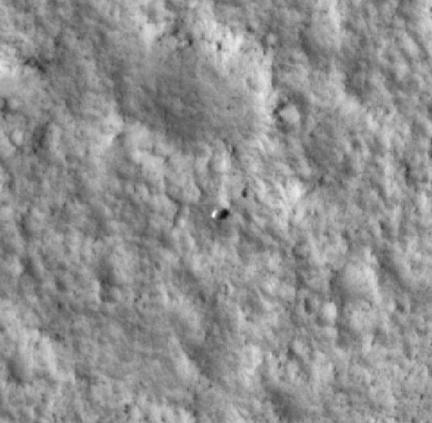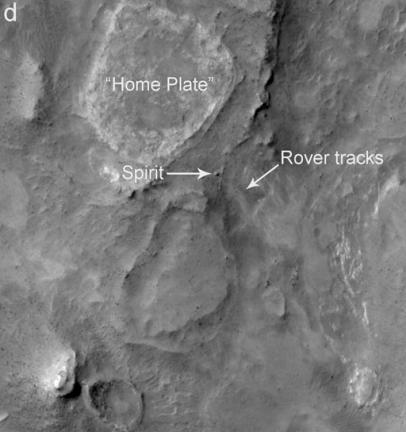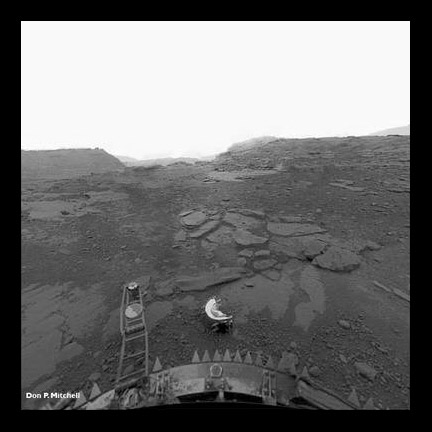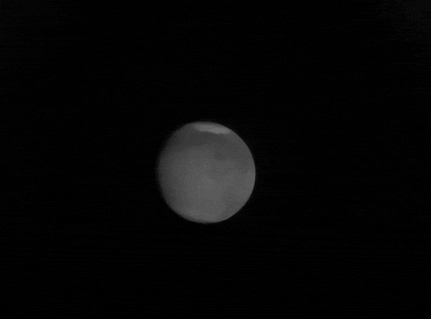 Similar... no?
Similar... no?
Old Tyme Mariner 7 Film Reel
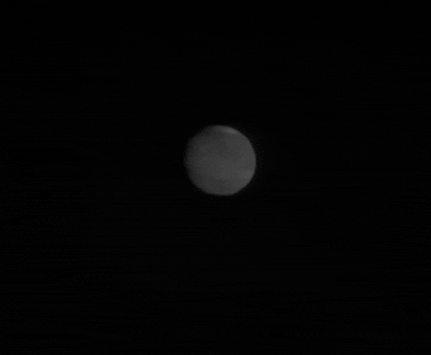 Ted Stryk, over at unmannedspaceflight.com (see “imager portfolios” in the right hand column), performed some handy work on these old Mariner 7 images on its approach to Mars. After the image clean-up work was completed he posted the files for download on the forum and wanderingspace worked the animation so that the trip to Mars would appear smoother. The result is very much as Ted describes as having, “a turn-of-the century nickelodeon look”, which is a pretty cool effect for an actual trip to Mars clip.
Ted Stryk, over at unmannedspaceflight.com (see “imager portfolios” in the right hand column), performed some handy work on these old Mariner 7 images on its approach to Mars. After the image clean-up work was completed he posted the files for download on the forum and wanderingspace worked the animation so that the trip to Mars would appear smoother. The result is very much as Ted describes as having, “a turn-of-the century nickelodeon look”, which is a pretty cool effect for an actual trip to Mars clip.
Mariner 7 was launched in March of 1969 and arrived in August of that same year. Shortly before arriving a battery exploded on board Mariner 7 and despite this near disaster, the Mariner team managed to get the spacecraft in fine working order just in-time for the encounter. A sister craft, Mariner 6, had flown by Mars only days before 7’s encounter and I intend to take a shot at arranging those frames for animation as well.
Wallpaper: Space Walk
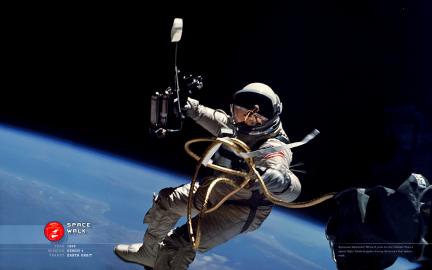 Ed White is the first American space walker, which took place on Mercury 7. Sadly, he later died on the ground in the tragic Apollo 1 flash fire which took place during a test run. The accident took the lives of 3 astronauts before Apollo even got off the ground.
Ed White is the first American space walker, which took place on Mercury 7. Sadly, he later died on the ground in the tragic Apollo 1 flash fire which took place during a test run. The accident took the lives of 3 astronauts before Apollo even got off the ground.
Note: I erroneously labeled this wallpaper as Mercury 7 and not Gemini 4. Image has been corrected.
Image Note: Some of the Earth image at the far left has been extended in Photoshop to fill out the space. The original image was square.
Wallpaper: Ariel Portrait
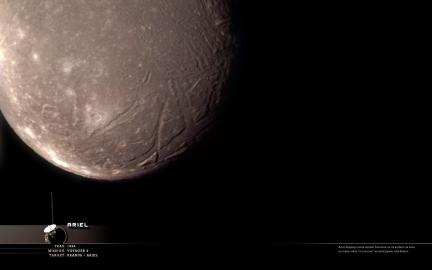 Ariel is the third of the five larger moons or Uranus. It is somewhat similar to Saturn’s Rhea in composition, about 30% rock and 70% ices. There are obvious ridges and details that would appear to be somewhat “young” features (which is still quite old to you and me), but there is little known about this moon as it was only viewed once from 127,000 km by Voyager 2.
Ariel is the third of the five larger moons or Uranus. It is somewhat similar to Saturn’s Rhea in composition, about 30% rock and 70% ices. There are obvious ridges and details that would appear to be somewhat “young” features (which is still quite old to you and me), but there is little known about this moon as it was only viewed once from 127,000 km by Voyager 2.
First Image From Space
Contrary to popular belief, the first man-made object to enter space was not Sputnik. An amazing factoid considering that the space race was a major battleground in the Cold-War between the Soviets and America. Oddly, very little information about these first rockets into space can be found almost anywhere. One of the best references is this article from Air & Space magazine’s web site. The article is centers around the fact that, in addition to being one of the first man-made objects in space (the first was actually German!), the V2s also returned the first images of Earth from space. On October 24, 1946, a V2 rocket was blasted off from White Sands Missile Range and climbed about 65 miles straight up. There it began snapping images until minutes later it fell back to Earth with no parachutes. The cannister containing the camera was smashed, but luckily the film itself was unharmed and was later developed revealing to us Earthlings a glimpse of our own world from higher up than we had ever seen before.

While the above image is fascinating enough… that image was shot on V2 #13 and later experiments also took cameras along for the ride. Considering how long ago these were taken, another image from V2 #21 taken in 1947 is even more impressive in its detail and clarity.

Wallpaper: Looking Back at Earth
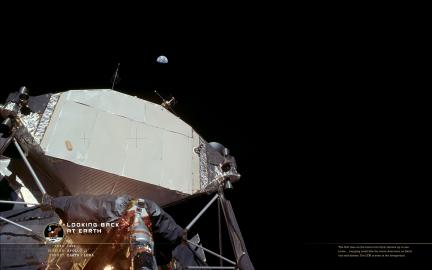 Trying to get some decent Apollo images on here from time to time. So many of these images are so often seen that I want to focus on the ones that really are great but are rarely seen.
Trying to get some decent Apollo images on here from time to time. So many of these images are so often seen that I want to focus on the ones that really are great but are rarely seen.
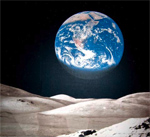 Seeing the size of Earth as it really appears from the surface of the moon reminds me of this wallpaper that I grew up with in my room as a child. I always assumed it was an actual image, but in reality the Earth appears about 1/20 the size and Earth would never phase in shadow from north to south under any circumstance! (I missed that obvious flaw as pointed out by Paul Neave). I beleive they still sell this wallpaper as I still see it around occasionally at stores and other public spaces (no pun). In addition to this image, you also see the Earth from moon shots taken while in- moon-orbit which also gives the Earth a far larger appearance… but I suspect that some good zoom lenses were likely utilized to get those looks as well.
Seeing the size of Earth as it really appears from the surface of the moon reminds me of this wallpaper that I grew up with in my room as a child. I always assumed it was an actual image, but in reality the Earth appears about 1/20 the size and Earth would never phase in shadow from north to south under any circumstance! (I missed that obvious flaw as pointed out by Paul Neave). I beleive they still sell this wallpaper as I still see it around occasionally at stores and other public spaces (no pun). In addition to this image, you also see the Earth from moon shots taken while in- moon-orbit which also gives the Earth a far larger appearance… but I suspect that some good zoom lenses were likely utilized to get those looks as well.
Wallpapers: Three From Apollo
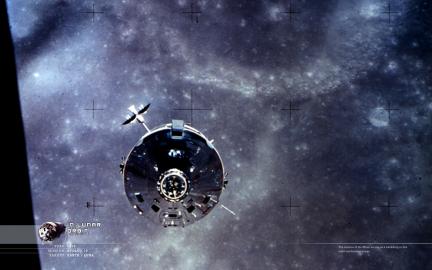 A few decades ago, about 12 men walked upon the surface of another celestial body for the first time in history. At one point, Neil Armstrong looked up at Earth and blotted it out with his thumb and thought the significance of that simple act. “That's home. That's us. On it, everyone you ever heard of, every human being who ever lived, lived out their lives. The aggregate of all our joys and sufferings, thousands of confident religions, ideologies and economic doctrines, every hunter and forager, every hero and coward, every creator and destroyer of civilizations, every king and peasant, every young couple in love, every hopeful child, every mother and father, every inventor and explorer, every teacher of morals, every corrupt politician, every superstar, every supreme leader, every saint and sinner in the history of our species, lived there on a mote of dust, suspended in a sunbeam”. While these were not Armstrong’s words, but instead Carl Sagan’s, it is clear that it is along these similar lines he was thinking.
A few decades ago, about 12 men walked upon the surface of another celestial body for the first time in history. At one point, Neil Armstrong looked up at Earth and blotted it out with his thumb and thought the significance of that simple act. “That's home. That's us. On it, everyone you ever heard of, every human being who ever lived, lived out their lives. The aggregate of all our joys and sufferings, thousands of confident religions, ideologies and economic doctrines, every hunter and forager, every hero and coward, every creator and destroyer of civilizations, every king and peasant, every young couple in love, every hopeful child, every mother and father, every inventor and explorer, every teacher of morals, every corrupt politician, every superstar, every supreme leader, every saint and sinner in the history of our species, lived there on a mote of dust, suspended in a sunbeam”. While these were not Armstrong’s words, but instead Carl Sagan’s, it is clear that it is along these similar lines he was thinking.
It is easy to forget how incredible those moments were as they happened so long ago, and the first of these was some months before I even existed as a person. We have grown accustomed to these images of men walking on the moon, in no small part because a follow up is so long overdue that they seem antiquated or quaint. So it seemed to me that out of 50 wallpapers uploaded it might be appropriate to include man’s first exploration of any of these places as part of the collection.
Wallpaper: Triton Cryo-Volcanos
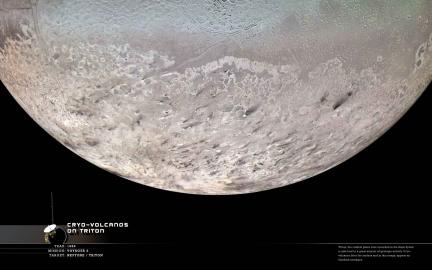 As of this time, Triton (a moon of Neptune) has the coldest temperature ever recorded in human history on any terrestrial surface… -235 C, -391 F. At these temperatures, nobody would have expected anything other than a huge frozen solid ice ball. Instead, Triton is littered with what we now call cryo-volcanos… or cold volcanos. They erupt or eject materials other than molten rock, such as water, ammonia or methane. As we are seeing in places like Titan (who is also suspected of having cryo-volcanos) many characteristics of Earth geology and weather are simulated elsewhere in the Solar System with different materials. On Earth it rains water, but on Titan it rains methane, and likewise on Triton it erupts probably liquid nitrogen instead of magma as it does here on Earth.
As of this time, Triton (a moon of Neptune) has the coldest temperature ever recorded in human history on any terrestrial surface… -235 C, -391 F. At these temperatures, nobody would have expected anything other than a huge frozen solid ice ball. Instead, Triton is littered with what we now call cryo-volcanos… or cold volcanos. They erupt or eject materials other than molten rock, such as water, ammonia or methane. As we are seeing in places like Titan (who is also suspected of having cryo-volcanos) many characteristics of Earth geology and weather are simulated elsewhere in the Solar System with different materials. On Earth it rains water, but on Titan it rains methane, and likewise on Triton it erupts probably liquid nitrogen instead of magma as it does here on Earth.
Only two active cryo-volcanos have been confirmed on Triton, but it is generally assumed that each one of those black smudges visible in this image are the remnants of recently active cryo-volcanos. There are quite a few…
More Landers on Mars from Orbit
Wallpaper: Miranda Portrait
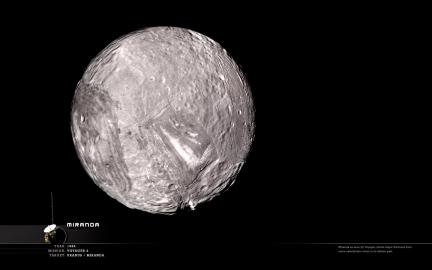 Of the five moons of Uranus, the only one to really stand out would be Miranda. One look at the moon suggests that some kind of cataclysmic event must have taken place in its past - huge fault canyons and ridges run across its surface. However, newer theories have replaced the idea that Miranda was shattered several times and instead suggest that somehow internal heating has caused lighter materials to rise up in various locations to the surface. Internal heating in smaller objects (Miranda is about 470km wide) is no longer an unexpected thing in the outer solar system. If it is ever confirmed that Miranda does in fact experience internal heating it will join Enceladus, Io and Europa (and possibly others) in this whole new class of body to be explored in the Solar System.
Of the five moons of Uranus, the only one to really stand out would be Miranda. One look at the moon suggests that some kind of cataclysmic event must have taken place in its past - huge fault canyons and ridges run across its surface. However, newer theories have replaced the idea that Miranda was shattered several times and instead suggest that somehow internal heating has caused lighter materials to rise up in various locations to the surface. Internal heating in smaller objects (Miranda is about 470km wide) is no longer an unexpected thing in the outer solar system. If it is ever confirmed that Miranda does in fact experience internal heating it will join Enceladus, Io and Europa (and possibly others) in this whole new class of body to be explored in the Solar System.
The Surface of Venus Revealed
During the cold-war between America and the Soviets the real race was to the moon, but once that race was won a lesser race began to see who would master Mars exploration. After an unbelievably long series of failed Soviet missions to Mars — America managed to take the lead position in Mars exploration as well, with the Mariner and Viking missions. So the Soviets turned their eyes to our other neighbor, Venus, which seemed to garner very little attention from America apart from a few flyby missions. The Russians had Venus all to themselves and really didn't have to be too concerned with anyone beating them to the punch.
So during the early 70’s the Soviets managed to be quite successful with multiple Venera missions to Venus which included various flybys, orbiters, radar mapping of the surface and even multiple landings on the surface. Some of the missions had failed, but most completed their missions and we have the above color images to prove it. Recently though, I stumbled across these projections of the above images which I have never seen before.
Someone who knows about such things, Don P. Mitchell (see more on his blog mentallandscape.com) had returned to the original data sent to us by the Venera spacecraft from over 30 years ago and with new computing techniques, managed to reveal to us Venus anew. Instead of just looking at some stones and tiny hints at what a Venusian sky might look like, these projections show what it might actually look like walking on the surface of Venus. The main part of the image above is a composite from spherical projections, which are seen at the top-right, remapped to perspective projections. The way the projection works is the closer you get to the very center of the image, the less accurate the representation may be. However, there is evidence in the data to assume most of what you see here even at the very center where the data was at most thin, is still fairly accurate.
Unfortunately the new projection images were only in black and white and i really missed what seemed to be really fascinating color from the original Venera images… so I tried to colorize it to match the originals.
This interpretation is artistic and not based upon any data other than looking at the original images and trying to assume some of those colors back into Don’s black and white image.
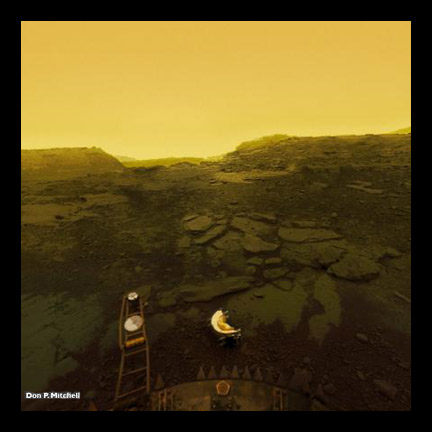
Wallpaper: Triton Portrait
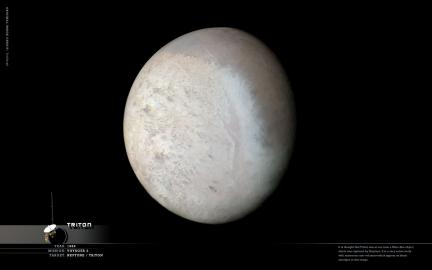 Another big surprise of the Voyager mission was the discovery that the coldest place in the solar system is also home to a considerable amount of geological activity. The moon appears to be widely populated by a large amount of cryovolcanos which were observed directly by Voyager in 1989. These volcanos can be seen in this image as small black smudges mostly located running across the center of the disk. It also has a tenuous atmosphere almost entirely composed of nitrogen.
Another big surprise of the Voyager mission was the discovery that the coldest place in the solar system is also home to a considerable amount of geological activity. The moon appears to be widely populated by a large amount of cryovolcanos which were observed directly by Voyager in 1989. These volcanos can be seen in this image as small black smudges mostly located running across the center of the disk. It also has a tenuous atmosphere almost entirely composed of nitrogen.
One of the most interesting bits of information about Triton to me is that the orbit runs in the opposite direction of Neptune’s rotation. This suggests that at one time, Triton may have been a dwarf planet captured by Neptune’s pull. This would also explain the lack of numerous moons which we see at many of the other gas giant planets. Triton would have swept through the Neptune system and probably either collided with or ejected whatever moons may have existed in the system. Triton also has a very slowly decaying orbit and will likely collide with Neptune or shatter into pieces to form a new ring system in 3.6 billion years.
Image Note: This is the orignal Triton portrait image that was posted to this site. The newer and improved main top image was recently generated by Ted Stryk and posted to unmannedspaceflight.com.
Wallpaper: Neptune Portrait
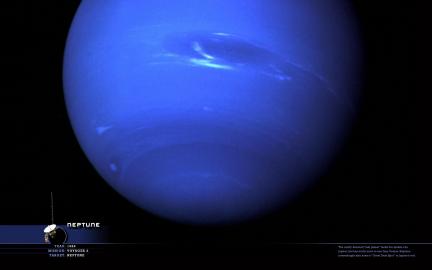 Neptune is the newly designated last “planet” in the solar system. It is the fourth gas giant and like Jupiter, it has its own “Great Red Spot” only in the case of Neptune it has been referred to as the “Great Dark Spot”. Like the other giants it also has a tenuous ring system and a system of moons. Only one of those moons, Triton, stands apart in size and characteristics and is one of the more interesting places to see in the solar system.
Neptune is the newly designated last “planet” in the solar system. It is the fourth gas giant and like Jupiter, it has its own “Great Red Spot” only in the case of Neptune it has been referred to as the “Great Dark Spot”. Like the other giants it also has a tenuous ring system and a system of moons. Only one of those moons, Triton, stands apart in size and characteristics and is one of the more interesting places to see in the solar system.
Wallpaper: Uranus Portrait
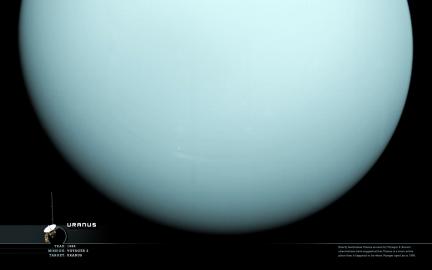 Second only to Mercury, Uranus tends to get the “boring” award from most due to its lack of almost any kind of cloud details. Among its five moons, there also isn’t really that much going on beyond what one might expect from such medium to small sized moons (with the possible exception of Miranda). However, there are a few things about Uranus that strike interest in it like the ring system, its axis is turned to about 98 degrees and more recently Hubble observations suggest that Uranus does have periodic cloud details not seen when Voyager flew past. As fate would have it, Uranus was in an unusually quiet mood in 1986.
Second only to Mercury, Uranus tends to get the “boring” award from most due to its lack of almost any kind of cloud details. Among its five moons, there also isn’t really that much going on beyond what one might expect from such medium to small sized moons (with the possible exception of Miranda). However, there are a few things about Uranus that strike interest in it like the ring system, its axis is turned to about 98 degrees and more recently Hubble observations suggest that Uranus does have periodic cloud details not seen when Voyager flew past. As fate would have it, Uranus was in an unusually quiet mood in 1986.
Wallpaper: Mercury Portrait
Sadly, Mercury has got to be the least interesting of the planets. It lacks any moons, lacks any substantial atmosphere and seems at a glance to be a duplicate of our own moon. At this point in time there has only been one mission to study Mercury up-close, Mariner 10 in 1973, so our information is quite limited. However, there is a mission on its way to Mercury right now named Messenger as well as a European/Japanese effort name Bepi-Columbo. Perhaps those missions will enlighten us all to things unseen on Mercury.
NOTE: This “portrait” wallpaper has been updated with a more recent color image taken during the January 2008 Messenger flyby.
Wallpaper: Mercury Up Close
No, its not our moon… its the planet Mercury. This is one of the best detailed images ever returned of Mercury and will likely remain so until Messenger reaches the planet in 2008 with an orbital insertion in 2011.
